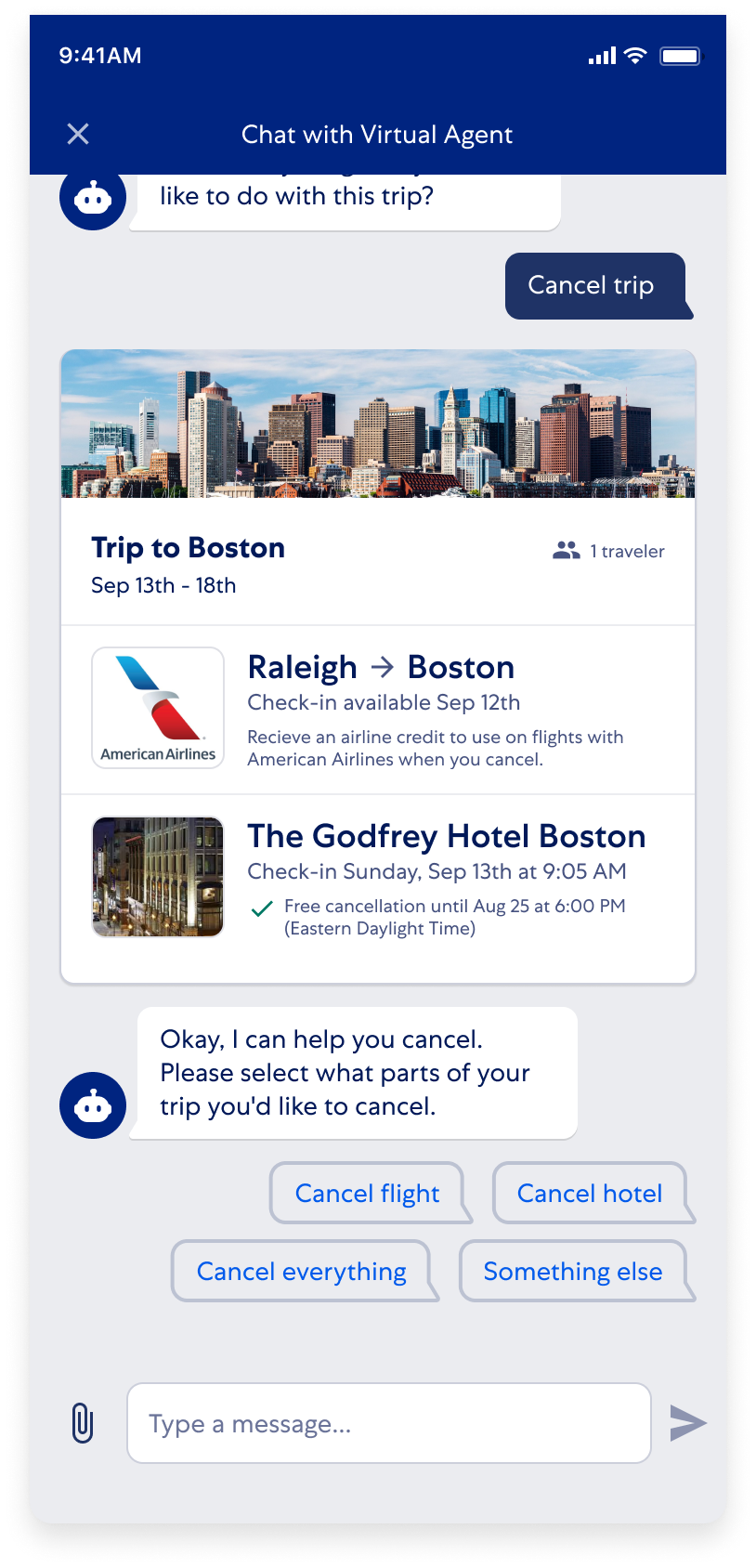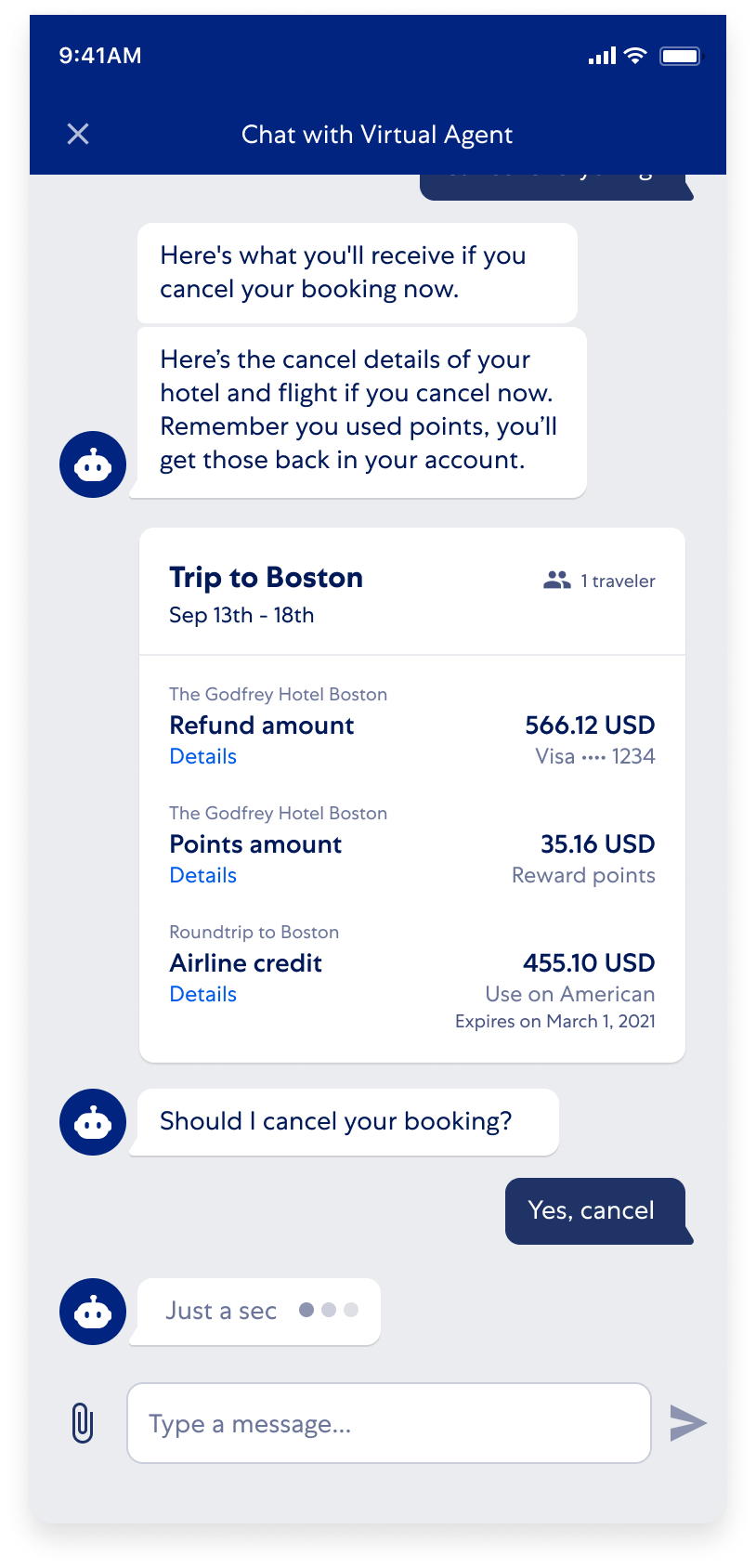
Chat Platform & Conversation Design
Skift, a media company that reports on travel industry trends, conducted a survey in 2018 that reported that 75% of respondents preferred to get customer service over phone and 25% over text-based channels (16% email & chat and 9% via social media). At that time, Expedia supported customers 90% over voice, 9% email, and 1% via chat and social media. There was a clear opportunity for Expedia to fill a much needed gap. While we had a chat service, it was antiquated, difficult for the travelers to discover, and had limited customer service representative support.
A lot has been accomplished since we started on the path to update the chat experience for not only our travelers, but also for our customer service representatives and Expedia partners. The direction ultimately brought us to develop not only an automated traveler- and customer-facing chat experience, but also a conversation platform that was built from the ground up.
Speed to Market
Expedia was behind the times and needed to catch up quickly. The product and engineering teams weighed the pros and cons between building a chat platform from scratch and utilizing a 3rd-party chat platform. In order to deliver quickly, the engineering team made a decision to go with Smooch.. The out-of-box (OOB) capabilities enabled the engineering team to develop fast. However Smooch’s OOB UI/UX capabilities were limiting. There wasn’t time to customize the code to fit the design vision that I and the team had.
While I had to manage the UX team’s expectations on waiting a bit longer to reach our vision, the time gained provided us and the rest of the organization some breathing room to learn a new way of design thinking. Up to this point, no one had experience with conversation design; especially when you add on bot automation. We were able to focus on researching, usability testing, and building new design thinking muscle around solving interesting interaction flows and design paradigms that conversation design presented.
I encouraged them not to be held back by traditional web flow experiences and UI. It was a perfect time to question the status quo and to not let those patterns get in the way of innovation. I often found myself saying, “Don’t worry about failing. Who knows, you might invent something new by setting yourselves free of all constraints.”
First Release Design Outcomes
Part of the design process was understanding the customer journeys for the different customer service intents that a traveler wanted to complete. Infographic journey maps were created to help feature teams and stakeholders align on the end-to-end processes, pain points and needs for our travelers. These journey maps were in essence the brains behind the automated bot skills that were created to solve the travelers’ intent.
Wherein the past workflow diagrams might have been skipped for non-chat experiences due to time constraints, they became a necessary part of the conversation UX design process. Not having a workflow diagram would be like driving across the United States without a map or GPS.
Chat experiences using Smooch
We delivered a mobile web and desktop experience in less than a year.
Results
NPS for chat increased by 2X over phone
14.2M conversations since launch
$40M savings in 1st half of 2020
Taking Control
The first release of the automated chat experiences made a big impact for our travelers, as well as the financial bottom-line. The money saved by customers servicing themselves was immediate.
However, there was more that I wanted to achieve in order to get closer to our vision. The less involved automated customer service tasks could be handled with simple chat dialogs that we’re all used to. But the complex use cases are painfully long when using pure conversational “chat bubble” UI. My vision included Introducing rich interactive experiences that utilize machine learning and what we know about the travelers to achieve a personalized and frictionless automated experience. Additional goals were to introduce richer webpage- and state-based UI. These experiences would allow design control at the markup level like layout, fonts, colors, images and more. The icing on the cake would be to do it all in a conversational way. Conversations fork and are not serial. I wanted to achieve a human-like allowed for interruptible workflows. My hypothesis was that we could potentially deflect the need for a traveler to be transferred to a live customer service agent if they could ask the bot a question at any time during the automated workflow, and then return back to where they left off.
The biggest blocker to achieving many of my and the teams’ goals were the limitations that were discovered with Smooch. Smooch was also acquired by a competitor. Ultimately, a decision was made to build the chat capabilities in-house given those factors and the Expedia-wide platform consolidation initiatives.
The following carousel shows examples that illustrate the vision that is currently being developed.









